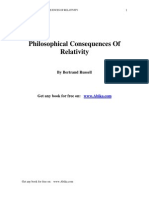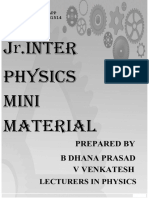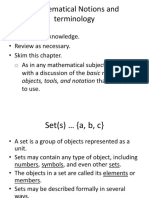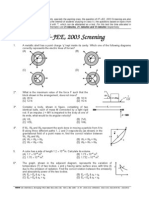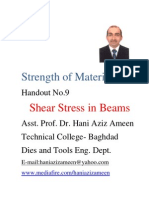Kardosh Special Relativity and The Time Lag Argument
Kardosh Special Relativity and The Time Lag Argument
Uploaded by
Francis CrimminsCopyright:
Available Formats
Kardosh Special Relativity and The Time Lag Argument
Kardosh Special Relativity and The Time Lag Argument
Uploaded by
Francis CrimminsOriginal Description:
Original Title
Copyright
Available Formats
Share this document
Did you find this document useful?
Is this content inappropriate?
Copyright:
Available Formats
Kardosh Special Relativity and The Time Lag Argument
Kardosh Special Relativity and The Time Lag Argument
Uploaded by
Francis CrimminsCopyright:
Available Formats
SOPHIA XI
Special Relativity and the Time-Lag Argument
JOHN KARDOSH UNIVERSITY OF ALBERTA
The time-lag argument in the philosophy of perception is often used as an argument against the Direct Realist theory of perception. In short, it is usually argued that because it takes time for the light transmitted (emitted or reflected) from the object of perception to reach the perceiver, perception cannot be of present stages of objects; rather, it must be the case that in perception what we perceive are past, presently non-existent stages of objects. Some Direct Realists, such as George Pitcher (1971) accept the consequences of the time-lag argument but insist that for Direct Realism all that is necessary is that perception is of external physical objects; and nothing for the Direct Realist, Pitcher argues, hangs on perception being of existent stages of those objects. More recently, R.W. Houts (1980) has argued that Pitchers concession to the time-lag argument has unfavorable consequences for the Direct Realist. Houts claims that if we maintain a Pitcher-type response to the time-lag argument, then it is impossible for us to be spatially related to the objects we perceive. In this paper, I contend that R.W. Houts argument against Pitchers response is uninformed. I show that Houts fails to formulate his argument in accordance with the laws of special relativity (STR), and this renders his position implausible. I also display that the STR rule of the relativity of simultaneity has similar consequences in the philosophy of perception to those that arise out of the time-lag argument. I argue that Pitchers response is the only response available to the Direct Realist grappling with the implications of STR.
23
Special Relativity and the Time-Lag Argument
In Some Implications of the Time-Lag Argument, R.W. Houts argues that George Pitchers defense against the time-lag argument can be taken as a reductio of the Direct Realist theory of perception. More Specifically, Houts argues that if the Direct Realist is willing to bite the bullet and agree that we can only ever perceive1 past physical events and stages (Houts, p. 150), then the Direct Realist is forced to admit that the following two propositions are false: 1. At a time, t, we (or our bodies) are at some spatial distance from the events and stages we perceive at t. 2. All the spatially noncontiguous events and stages we perceive at a time are or were at some spatial distance from one another. (p. 156) Houts, however, insists that it is overwhelmingly plausible that these two propositions are true. Indeed, it does seem reasonable to maintain that we stand at some spatial distance to the external objects we now perceive, and that these objects of perception stand at some spatial distance to one another. Nevertheless, as Houts contends, we cannot be at a spatial distance from stages of objects that no longer exist, and stages of objects that no longer exist cannot be at a spatial distance from one another. 2 In a similar regard, one cannot be at a spatial distance from the golden mountain, and the golden mountain cannot be at a spatial distance from the golden valley, because non-existent objects are not spatially located. Houts, therefore, concludes that the Direct Realist responsethat we can only ever perceive past physical events and stages (ibid)to the time-lag argument, reduces the Direct Realist theory of perception to absurdity. Nevertheless, Houts argument is incomplete, because it does not account for the implications that the special theory of relativity (STR) has for the time-lag argument. It will be the principle task of this paper to show that a time-lag in perception is unavoidable, given that light travels with a finite constant velocity. In the first part of this paper, I will show that Houts argument against Direct Realism looses its intuitive force once we realize that his above two propositions are implausible under the
1
The term perception in this paper will refer exclusively to visual perception. 2 This is not, however, to make the stronger claim that we are never at a spatial distance from objects in the physical world, or that objects in the physical world are not at a spatial distance from one another. Rather, the claim is only that, if we accept the implications of the time-lag argumentthat it takes time for the light necessary for perception to reach the perceiverthen we can never perceive objects at a spatial distance from ourselves, or from one another.
24
SOPHIA XI
constraint of STR. Houts may be right in saying that Pitchers response to the time-lag argument is less than desirable, but he fails to realize that Pitchers response is the only one available to the Direct Realist. The last part of this paper will address some further problems that arise out of STR. In short, I argue that the relativity of simultaneity leads to a type of perceptual relativity, where innumerably many, equally valid, reference frames exist in perception; a result of this is that the Direct Realist is cornered into a position where she must make another Pitcher-type response. First, it will be expedient to give a brief exposition of the Direct Realist theory of perception. Direct Realism in the philosophy of perception is the view that the immediate (or direct) objects of perception are external objects, events and stages. 3 That is to say, a Direct Realist holds that in cases of veridical perception, what we perceive immediately are mindindependent external objects. The most radical Direct Realists will also usually maintain that the object of perception must be contemporaneous with the perception of which it is the object (Robinson, 81); if the object of perception is not contemporaneous with the perception of which it is the object, then the object of perception does not correspond to a present physical object, event or stage in the external world. The Direct Realist, then, must hold that the object of perception is contemporaneous with the perception of which it is the object, if the Direct Realist wants to hold that the immediate object of perception corresponds to an existent object in the physical world. The time-lag argument undermines the Direct Realist theory by showing that the immediate object of perception cannot be contemporaneous with the perception of which it is the object. In other words, the argument displays that the immediate object of perception cannot be a presently existent stage or event in the external world. In its most standard formulation, the time-lag argument is motivated by the fact that light travels with a finite speed ),4 and then shows that because of the finite speed of light it is impossible for the object of perception to be contemporaneous with the perception of which it is the object. Consequently, if the object of perception is not contemporaneous with the perception of which it is the object, then the object of perception cannot be a presently existent external object, event
3
A stage of a physical object can be thought of as an event a slice out of the history of the object (Houts, 153). 4 It is a law of STR that the speed of light is both constant and finite in all reference frames.
25
Special Relativity and the Time-Lag Argument
or stage. For instance, against Direct Realism, it can be argued that it is an uncontroversial fact that when we perceive celestial bodies, some of those bodies no longer exist; thus, with regards to the perception of astronomical phenomena, in some cases what we perceive are no longer existent objects in the external world (Robinson, p. 80). While the appeal to non-existent celestial bodies, in no doubt, strengthens the argument, the true force comes from the fact that, even with regards to objects in our immediate environment, it takes time, how ever short it may be, for the perceiver to receive the light transmitted from the object of perception. So, even with regard to nearby objects, we can never perceive them as they are at a present time, but only ever as they were some time prior to a present time, because light always travels with a finite speed. Therefore, the immediate object of perception must be something either non-existent or non-physical. The Direct Realist, however, cannot hold the latter, 5 so she is forced to assert that the immediate object of perception is something presently non-existent. The common response for a Direct Realist to make to the timelag argument is to bite the bullet and agree that we can only ever perceive past physical events and stagesnon-existents. 6 George Pitcher articulates this concession well when he states that:
[A Direct Realist] can simply insist that the finite speed of light does not entail that we do not directly see things and states of affairs in the external world, but only that we must see them as they were some time ago. We see real physical things, properties, and events, all right, but we see them late, that is all. According to a direct realist, it is a mere prejudice of common senseand one on which the time-lag argument tradesthat the events, and the states
This will not be discussed at length here; however, it should be noted that if the Direct Realist holds that the immediate object of perception is something nonphysical a sense datum, then they have given up Direct Realism. 6 Recently, A.D. Smith has used non-existent objects in his response to the problem of hallucinatory perception. In short, he claims that, in cases of perceptual hallucination, what one is aware of is a (Meinongian) non-existent object. I think that a similar response to the time-lag argument, as that of Smiths to the problem of hallucination, is available to the Direct Realist; however, it seems untenable to me that all perception is of non-existent objects. I lack space to pursue this point further; but for a more informed discussion see A.D. Smith, The Problem of Perception, (Harvard University Press. 2002).
26
SOPHIA XI
of objects, that we see must be simultaneous with our seeing them. (Pitcher, p. 48)7
It is apparent that Pitchers response in this passage is what fuels Houts argument. The Direct Realist, Houts asserts, wishes to maintain that a Direct Realist theory of perception can remain coherent and still carry on a Pitcher-type response. That is to say, a Direct Realist can reject the above claim that the immediate object of perception must be contemporaneous with the perception of which it is the object; and instead, she can maintain the weaker claim that the immediate object of perception need only be of an external stage of an object, and not of a present temporal (existent) stage of that object (Suchting, 50). However, while this weaker claim may remain consonant with a Direct Realist 8 theory of perception, Houts argues that such a defense is incompatible with his aforementioned two propositions. This alone, for Houts, warrants a reason to reject a Pitcher-type response as a plausible defense against the time-lag argument. As mentioned above, in order to perceive a spatial distance, in Houts view, a perceiver must perceive an object as it is; and in order for objects to have spatial distance from one another, they must coexist.9 For instance, lets imagine an event (E) where two billiard balls (A and B) strike each other; and lets also imagine that a perceiver (Smith) is watching E. Now, because of the time it takes the light transmitted from E (A and B striking each other) to reach Smith, what Smith sees when he looks at E is a past stage (A and B at the moment of impact), but A and B at the present stage have already collided (lets call this new event E). Houts will then argue that Smith, in our thought experiment, is at a spatial distance from E, and A and B are at a spatial distance in the E scenario; but Smith does not perceive E, Smith perceives E; thus, Smith is not at a spatial distance from what he perceives (a past stageE); and likewise, Smith does not perceive a spatial distance between A and B, because A and B, in his view, are prior to E, when in reality A and B are presently at E. But this conclusionthat propositions one and two are
7
For an in depth discussion of Pitchers response to the time-lag argument, see, G. Pitcher, A Theory of Perception, (Perception: Princeton Univ. Press. 1971). 8 The radical Direct Realist, sometimes referred to as a Nave Realist, will not be able to maintain this weaker claim. It is essential to Naive Realism that the object of perception be contemporaneous with the perception of which it is the object. 9 Houts wants to say that two objects that coexist share a spatial relationship because they exist at the same temporal moment (Houts, 154).
27
Special Relativity and the Time-Lag Argument
falseHouts claims, is counterintuitive, because when we look at objects and events in the world we tend to think that these objects and events are at a spatial distance from us, as well as from one another. Houts, therefore, concludes that if Pitchers is the best response to the time-lag argument, then Direct Realism is an untenable theory of perception.10 Nevertheless, Houts argument looses its intuitive force once we consider the implications of STR. In STR, the notion of spatial distance becomes highly relativised, and a new notion of spatiotemporal distance must be introduced. As such, when we describe a relation between a perceiver and an object, or an object and another object, it only makes sense to say that the perceiver occupies a spatialtemporal relation to the objects she perceives, and that objects occupy spatial-temporal relations to one another. So, if we were to describe our above thought experiment again, we would need to say that Smith is at a spatial distance of x (where x signifies a set distance) and a temporal distance of t (where t signifies a set time) from E, and Smith is at a distance11 of xt from E. Houts makes a point of specifying in his propositions that it is because we cannot perceive events as they are, but only ever as they were that we have to deny one and two. While this shows that Houts is, indeed, specifying a type of spatio-temporal relationship, it is not one that fits well into STR. Houts confusion lies in trying to separate a temporal relation from a spatial relation: he claims that we can only have a spatial relation between objects at ta present time. However, as I said, there is no such separation in relativity theory. According to STR, perceivers are spatially-temporally related to objects, and objects are so related to one another. Thus, when we consider STR, the propositions Houts uses in his argument loose their appeal: a perceiver could only perceive an object as it is if she could occupy the same spatial-temporal point as the object of perception, but this is impossible. On a Minkowski diagram12 we cannot draw two intersecting world lines if there is a distance between the objects. Houts argument,
10
For an alternative response to the time-lag argument, see, e.g., W.A. Suchting, Perception and the Time-Gap Argument, Philosophy Quarterly, pp. 44-56, and H.Robinson, Perception, Routledge, 1994. 11 Unless otherwise specified, I will use distance from here on to signify spatialtemporal distance. 12 In STR, Minkowski diagrams allow for the illustration of the properties of space and time, and for the quantitative understanding of certain phenomena like time dilation and length contraction without mathematical equations.
28
SOPHIA XI
therefore, is absurd in its own right, and does not constitute a persuasive objection against Direct Realism. This response to Houts argument should, nevertheless, inspire us to consider the implications that an STR version of the time-lag argument has on Direct Realism. What remains consistent in the STR version of the time-lag argument with the version stated above is the key premise that light always travels with a finite speed. As such, if we consider a single inertial frame as our perceiver (Smith), then it is a consequence of the finite speed of light that Smith will only ever be able to perceive objects, events and stages at a later time than the time the light, that carries the information necessary for perception, is transmitted from these objects, events and stagesthe minimum lapse being the closest distance a perceiver can be to the worldline of light transmitted by the object of perception. The only way, then, that it would be possible to perceive objects in the physical world without a lapse in time would be if we could somehow occupy the same spatial-temporal point (at the origin on a Minkowski diagram) as the object of perception, which is not a possibility for numerically distinct objects. It will always be the case that from the objects reference frame, the light transmitted occurs at the origin, and from the perceivers reference frame, the light is received at xt (some distance from the origin). 13 Hence, Pitchers response, for a Direct Realist, is the only adequate response to the time-lag argument. It should now be clear that it is merely a consequence of STR that a time-lag in perception is unavoidable. Pitchers concession acknowledges this point. STR, however, creates other problems for Direct Realism. Up till now we have been considering how the time-lag, in conjunction with the principles of STR, pushes the Direct Realist into a position where they must concede that the object of perception cannot
13
It is possible to argue that the temporal present could in fact be extended long enough so that the light transmitted from the object of perception arrives at the perceiver during the same temporal moment. This attempt fails in STR because the notion of the present is a space-time point that is an infinitesimal degree above zero, which means a time-lag would still be prevalent. One might still contend that the spatial-temporal present is bounded to a degree equivalent to that of the speed of light in all inertial frames, making the lag insignificant; for why this cannot be the case, see, e.g., H. Stein, On Relativity Theory and the Openness of the Future, Philosophy of Science, Vol. 58, No. 2 (June, 1991), pp. 147-167. Also, we must consider that the actual time-lag will also take into account the time it takes for a percept to be elicited in the perceiver through a series of neural pathways. The time it takes for this biological process to transpire in the perceiver will make the time-lag readily apparent.
29
Special Relativity and the Time-Lag Argument
be contemporaneous with the perception of which it is the object. This is a problem that occurs for any one perceiver occupying any given reference frame. But if we introduce more than one perceiver into the picture, then we also have to address the perceptual relativity 14 that results because of the relativity of simultaneity. It is a consequence of STR15 that the notion of simultaneity is dependent on the reference frame (perceiver). That is to say, it is impossible to say in an absolute sense whether two events occur at the same time if they are separated spatial-temporally. What we can say, however, is that if we have two perceivers watching the same object, event or stage, neither will be able to see the object, event or stage bellow the minimum lapse. Nevertheless, it is possible for one or both to see the object, event or stage at a greater lapse. For instance, if two flashes of light are emitted at two ends of a moving train (stipulating for now that on a Minkowski diagram both flashes are on the time axis at zero, but are at different points on the space axisone flash at the right end (R), and one at the left end (L)), and there is a perceiver (Smith) in the middle of the train, and another perceiver (Gilbert) on the middle of a platform that the train is traveling towards (the right end being the front of the train), then Smith, being inside the train reference frame at an equal distance from L and R, will say he sees the two flashes simultaneously; however, Gilbert on the other hand, will say that he sees R before he sees L, because, from Gilberts reference frame, R has less distance to cover to get to the middle of the train than does L (Kosso, 51-56). Furthermore, also stipulating that both Smith and Gilbert have synchronized clocks (i.e., they must count units of time at the same rate, and they must simultaneously indicate the same time), then Smith will perceive that L and R reach him at the same time t, whereas Gilbert will perceive that R reaches Smith at t and that L reaches him at t. 16 This, however, does not mean that Smith sees the event (the simultaneous light flashes) as it really is, and Gilbert does not; on the contrary, there is no one objective frame in STR. As a result of there being no objective frame, if everything else is held equal, then the Direct Realist is forced to concede that Smith perceiving both L and R at t is compatible with
14
By perceptual relativity, I mean the relativity between the time at which objects are perceived in different reference frames. 15 It is specifically a consequence of the constant speed of light in STR that simultaneity becomes relativised. 16 The times designated here are not important. I only wish to clarify the relativity of simultaneity.
30
SOPHIA XI
Gilberts perceiving R at t and L at t; and a similar conclusion must hold true for innumerably many different reference frames. Moreover, this also entails that while the time-lag will never go bellow the minimum lapse (i.e., in this case we will say Gilberts seeing R), it can be greater than this minimum lapse (i.e., Smiths seeing L and R, or even greater still, Gilberts seeing L). Since, the Direct Realist is willing to make a Pitcher-type concession to the time-lag argument, then they will most likely make the same concession to perceptual relativitythe immediate object of perception need only be of an external stage of an object. To what extent this concession affects Direct Realism is not clear; nevertheless, we have shown that the Direct Realist is forced to make this concession. In this paper I have presented the time-lag argument from an informed discussion of STR in order to show that Direct Realists are forced to admit that perception is always of past physical events and stagesnon-existents. I have displayed that the force of the time-lag argument relies on the fact that light has a constant finite velocity. The constant velocity of light from STR has also allowed me to show that it is impossible to go bellow the minimum-lapse in the time it takes light transmitted from the object of perception to reach the perceiver. Although it is impossible to go bellow this minimum, when more than one perceiver is introduced into the equation, the relativity of simultaneity shows that it is possible for the time-lag to increase, and for perceptual relativity to occur between two or more perceivers with synchronized clocks. As a result of these implications of STR on the time-lag argument, Houts argument against Direct Realism looses its intuitive force. In the end, the Direct Realist still has the ability to maintain a Pitcher-type response to the problems that arise when we consider the relation between STR and perception; whether this is a favorable move, is still left open. Works Cited Houts, R.W. Some Implications of the Time-Lag Argument, Philosophy and Phenomenology Research, 41 (1980), pp. 150-157. Kosso, P. Appearance and Reality: An introduction to the Philosophy of Physics, Oxford University Press, (1990), pp. 21-93. Pitcher, G. A Theory of Perception, Princeton: Princeton University Press, 1971. Robinson, H. Perception. Routledge, 1994. Smith, A. D. The Problem of Perception, Cambridge, Mass.: Harvard University Press, 2002.
31
Special Relativity and the Time-Lag Argument
Stein, H. On Relativity Theory and the Openness of the Future, Philosophy of Science, Vol. 58, No. 2 (June, 1991), pp. 147-167. Suchting, W.A. Perception and the Time-Gap Argument, Philosophy Quarterly, 19 (1969), pp. 44-56.
32
You might also like
- 01 - Introduction To Causality - Causal Inference For The Brave and TrueDocument11 pages01 - Introduction To Causality - Causal Inference For The Brave and TrueDachuan ZhangNo ratings yet
- Calin o An Informal Introduction To Stochastic Calculus WithDocument331 pagesCalin o An Informal Introduction To Stochastic Calculus Withjldelafuente100% (5)
- Clavicula Nox Issue 1 Abraxas PDFDocument50 pagesClavicula Nox Issue 1 Abraxas PDFFrancis Crimmins100% (7)
- The Inverse Theory of Relativity, An Alternative To UnificationDocument31 pagesThe Inverse Theory of Relativity, An Alternative To Unificationhannah skeltonNo ratings yet
- Clavicula Nox Issue 3 AzathothDocument22 pagesClavicula Nox Issue 3 AzathothFrancis CrimminsNo ratings yet
- Albert Pike Morals and DogmaDocument1,121 pagesAlbert Pike Morals and DogmaFrancis Crimmins100% (1)
- Magenta ManualDocument59 pagesMagenta Manualquiensois9665No ratings yet
- Michael Beaton: Sensorimotor Direct Realism: How We Enact Our WorldDocument33 pagesMichael Beaton: Sensorimotor Direct Realism: How We Enact Our WorldilinxxNo ratings yet
- Wovon Man Nicht Sprechen Kann, Darüber Muß Man Schweigen." "Whereof One Cannot Speak, Thereof One Must Be Silent."Document5 pagesWovon Man Nicht Sprechen Kann, Darüber Muß Man Schweigen." "Whereof One Cannot Speak, Thereof One Must Be Silent."Robert ZieglerNo ratings yet
- Sentences-In-Themselves. Later Philosophers, Such As Lotze, Frege, and Husserl, WouldDocument19 pagesSentences-In-Themselves. Later Philosophers, Such As Lotze, Frege, and Husserl, WouldAhmet BozyiğitNo ratings yet
- Bertrand Russell - Philosophical Consequences of RelativityDocument5 pagesBertrand Russell - Philosophical Consequences of RelativitypendleNo ratings yet
- Jcruickshank FPDocument16 pagesJcruickshank FPLars PlougNo ratings yet
- Whitehead Ian PhysicsDocument25 pagesWhitehead Ian Physicsmszlazak4179100% (1)
- Meillassoux - Time Without BecomingDocument12 pagesMeillassoux - Time Without BecomingDarko DraškovićNo ratings yet
- Nikolic FQXi TimeDocument7 pagesNikolic FQXi TimeJose M. Dorantes BolivarNo ratings yet
- Space and Time As Relations: The Theoretical Approach of LeibnizDocument15 pagesSpace and Time As Relations: The Theoretical Approach of LeibnizmlkNo ratings yet
- Causality in Contemporary Physics - SchlickDocument56 pagesCausality in Contemporary Physics - SchlickwalterhornNo ratings yet
- Foster - The Nature of PerceptionDocument229 pagesFoster - The Nature of PerceptionRyan TigerNo ratings yet
- Indirect Perception and Sense DataDocument14 pagesIndirect Perception and Sense Dataes2344No ratings yet
- Realism and Idealism The TermsDocument8 pagesRealism and Idealism The Termsrhofel reyesNo ratings yet
- Quentin Meillassoux Time Without BecomingDocument52 pagesQuentin Meillassoux Time Without Becomingsoufi2014No ratings yet
- Haack, S. 1979 Descriptive and Revisionary MetaphysicsDocument11 pagesHaack, S. 1979 Descriptive and Revisionary MetaphysicsNoSeNo ratings yet
- Brassier, Jameson on Making History AppearDocument8 pagesBrassier, Jameson on Making History AppearRafael SchettinoNo ratings yet
- 2 Naïve and Scientific RealismDocument5 pages2 Naïve and Scientific RealismValentin MateiNo ratings yet
- Document 5Document5 pagesDocument 5Dragos ManeaNo ratings yet
- Relativity Theory May Not Have The Last Word On The Nature of Time - Quantum Theory and ProbabilismDocument13 pagesRelativity Theory May Not Have The Last Word On The Nature of Time - Quantum Theory and ProbabilismAndre Lanzer100% (1)
- Kant's Refutations of IdealismDocument4 pagesKant's Refutations of IdealismAnonymous ZS464aLNo ratings yet
- Acton-Boxborough-NeKa-Aff-Apple-Valley-Minneapple-Debate-Tournament-Round-2Document7 pagesActon-Boxborough-NeKa-Aff-Apple-Valley-Minneapple-Debate-Tournament-Round-2PMDEGENo ratings yet
- Events and Things _ Issue 15 _ Philosophy NowDocument5 pagesEvents and Things _ Issue 15 _ Philosophy NowKomkor GuyNo ratings yet
- Annotated-Suckow - Jonathan - Final 2Document3 pagesAnnotated-Suckow - Jonathan - Final 2jonathan suckowNo ratings yet
- 20123095Document25 pages20123095Beniamimus BarnettusNo ratings yet
- Process Physics Ecological Realism and T PDFDocument23 pagesProcess Physics Ecological Realism and T PDFJeroenBJvanDijkNo ratings yet
- John Milbank, The Thomistic Telescope: Truth and IdentityDocument76 pagesJohn Milbank, The Thomistic Telescope: Truth and Identityam050804100% (1)
- Is The Mind/Soul A Platonic Akashic Tachyonic Holographic Quantum Field?Document25 pagesIs The Mind/Soul A Platonic Akashic Tachyonic Holographic Quantum Field?Admin JohnNo ratings yet
- Kansas PDFDocument14 pagesKansas PDFCarlos Mario MorenoNo ratings yet
- Boi Luciano - Questions Regarding Husserl Geometry and PhenomenologyDocument61 pagesBoi Luciano - Questions Regarding Husserl Geometry and PhenomenologyGabriela De GanteNo ratings yet
- Parrhesia19 GarciaDocument13 pagesParrhesia19 Garciajoeromano22No ratings yet
- The Images of Time Robin Le PoidevinDocument4 pagesThe Images of Time Robin Le PoidevinLed Media PlusNo ratings yet
- Draft: Chris Nunn. New Directions in Consciousness Studies. Routledge. 2016Document6 pagesDraft: Chris Nunn. New Directions in Consciousness Studies. Routledge. 2016Donita SotolomboNo ratings yet
- Space, Time and Emergence: 1 Emergence Hides The True Nature of ThingsDocument14 pagesSpace, Time and Emergence: 1 Emergence Hides The True Nature of Thingsstephane VernedeNo ratings yet
- Amsmath Example-5Document10 pagesAmsmath Example-5Abhiroop SatheeshNo ratings yet
- Transcendental RealismDocument18 pagesTranscendental RealismAnonymous slVH85zYNo ratings yet
- Naturalismo Vs Trascendentalismo (Inglés)Document14 pagesNaturalismo Vs Trascendentalismo (Inglés)sandroNo ratings yet
- Partners of Gravity How We Move Our OwnDocument11 pagesPartners of Gravity How We Move Our OwnAnonymous pZ2FXUycNo ratings yet
- Russell EXPERIENCETIME 1915Document23 pagesRussell EXPERIENCETIME 1915lw130003No ratings yet
- Timeless UniverseDocument4 pagesTimeless UniverseAlec LoaiNo ratings yet
- Newton's Views On Space, Time, and Motion: First Published Thu 12 Aug, 2004Document19 pagesNewton's Views On Space, Time, and Motion: First Published Thu 12 Aug, 2004sonirocksNo ratings yet
- Gabriel 2015Document16 pagesGabriel 2015Pagan ReignNo ratings yet
- What Is The Relation Between An Experien PDFDocument37 pagesWhat Is The Relation Between An Experien PDFAnonymous pZ2FXUycNo ratings yet
- Physics and Common SenseDocument17 pagesPhysics and Common SenseChandramohan MuruganNo ratings yet
- DAriano - FQXi2013-It From BitDocument10 pagesDAriano - FQXi2013-It From Bitfware28No ratings yet
- Ontological Mathematics Versus Einstein's Special Theory of RelativityFrom EverandOntological Mathematics Versus Einstein's Special Theory of RelativityRating: 5 out of 5 stars5/5 (1)
- God in A Quantum World PDFDocument17 pagesGod in A Quantum World PDFOarga Catalin-Petru100% (1)
- Document 4Document2 pagesDocument 4Dragos ManeaNo ratings yet
- Limits of LogicDocument6 pagesLimits of LogicSalimangalam L SriramNo ratings yet
- Response 1 - PhenomenologyDocument1 pageResponse 1 - PhenomenologyChris ChiaseraNo ratings yet
- Arthur M. Young - The Geometry of Meaning: Chapter XII - Free WillDocument22 pagesArthur M. Young - The Geometry of Meaning: Chapter XII - Free WillNguyenNo ratings yet
- What Can We Learn About The Ontology of Space and Time From The Theory of Relativity? A SynopsisDocument9 pagesWhat Can We Learn About The Ontology of Space and Time From The Theory of Relativity? A SynopsiskaubreyNo ratings yet
- God, Time and SpacetimeDocument6 pagesGod, Time and SpacetimeRobert Francis AquinoNo ratings yet
- Relativity of the Half-Being of Representation - from Philosophy to Mathematics and Science (Logic as Science)From EverandRelativity of the Half-Being of Representation - from Philosophy to Mathematics and Science (Logic as Science)No ratings yet
- An Intuitionistic Way to Ultimate Reality: Unlocking the Mysteries of Man and His UniverseFrom EverandAn Intuitionistic Way to Ultimate Reality: Unlocking the Mysteries of Man and His UniverseNo ratings yet
- Motion Integration Postdiction Visual Awareness Eagleman 2000Document4 pagesMotion Integration Postdiction Visual Awareness Eagleman 2000Francis CrimminsNo ratings yet
- (NP) The Sepher YetzirahDocument23 pages(NP) The Sepher YetzirahgherrouNo ratings yet
- Arthur Avalon Introduction To Tantra ShastraDocument164 pagesArthur Avalon Introduction To Tantra ShastraFrancis Crimmins100% (7)
- JR Physics Mini Material 08122022 OnlineDocument40 pagesJR Physics Mini Material 08122022 Onlineramakrishnamasina9999No ratings yet
- Trigo IgcseDocument8 pagesTrigo IgcseAurna BanerjeeChowdhuryNo ratings yet
- Signal Delay Notes Ce780a 2020Document2 pagesSignal Delay Notes Ce780a 2020AbuBakerNo ratings yet
- 2395 CH 15Document19 pages2395 CH 15abdülkadir cebeciNo ratings yet
- 425-99Z - Article Text-2743-1-4-20230803Document7 pages425-99Z - Article Text-2743-1-4-20230803IrfanNo ratings yet
- Chapter 5 - Excursion B-Splines - Commented2Document47 pagesChapter 5 - Excursion B-Splines - Commented2DreamlessNo ratings yet
- 9709 s10 QP 63Document4 pages9709 s10 QP 63Hubbak KhanNo ratings yet
- Class Notes - ADC For Numerical RelayDocument5 pagesClass Notes - ADC For Numerical RelaybiswajitsahooNo ratings yet
- Corona Leave Assignment - EmechDocument14 pagesCorona Leave Assignment - EmechraghulNo ratings yet
- Control Theory With MathScript ExamplesDocument87 pagesControl Theory With MathScript ExamplesvelmuruganNo ratings yet
- Mechatronics Syllabus Regulation 2013.Document94 pagesMechatronics Syllabus Regulation 2013.sivaeeinfoNo ratings yet
- Os MCQDocument21 pagesOs MCQgurusodhiiNo ratings yet
- Impulse Power Secrets-3docDocument8 pagesImpulse Power Secrets-3doc77nicuNo ratings yet
- Question Set For PEDocument4 pagesQuestion Set For PEyawuNo ratings yet
- Year 4 Maths Test - Word Problems Mixed Operations - AnswersDocument7 pagesYear 4 Maths Test - Word Problems Mixed Operations - AnswersMoodjair IkanNo ratings yet
- Big English 2 - Video Activity - UNIT 1Document3 pagesBig English 2 - Video Activity - UNIT 1zelindaaNo ratings yet
- Mathematical Notations and Set TheoryDocument63 pagesMathematical Notations and Set TheoryshimelisNo ratings yet
- FIITJEE Solutions To IIT JEE-2003 Screening PaperDocument20 pagesFIITJEE Solutions To IIT JEE-2003 Screening Paperblue_l1No ratings yet
- Iso Cie 11664-6-2014Document18 pagesIso Cie 11664-6-2014Kuya Fabio VidalNo ratings yet
- Lab 5 Design & Implementation of Half Adder & Subtractor Using Universal GatesDocument5 pagesLab 5 Design & Implementation of Half Adder & Subtractor Using Universal GatesEngr. Raheel khanNo ratings yet
- Solution To Problem 110Document1 pageSolution To Problem 110Arabella RiveraNo ratings yet
- MAT09-Example Exercises (Week 8)Document4 pagesMAT09-Example Exercises (Week 8)Mabeth Placino-SeñoNo ratings yet
- En 15242Document54 pagesEn 15242zouloumisleNo ratings yet
- 12) FINA 2303 - Spring 2017 - Chapter 12 - 8april17Document178 pages12) FINA 2303 - Spring 2017 - Chapter 12 - 8april17Sing On LukNo ratings yet
- Strength of Materials - Shear Stress in Beams - Hani Aziz AmeenDocument40 pagesStrength of Materials - Shear Stress in Beams - Hani Aziz AmeenHani Aziz Ameen100% (2)
- Ai Assignment 1Document5 pagesAi Assignment 1issaalhassan turayNo ratings yet
- Picking The Correct DistributionDocument2 pagesPicking The Correct DistributionAddityaChauhanNo ratings yet










